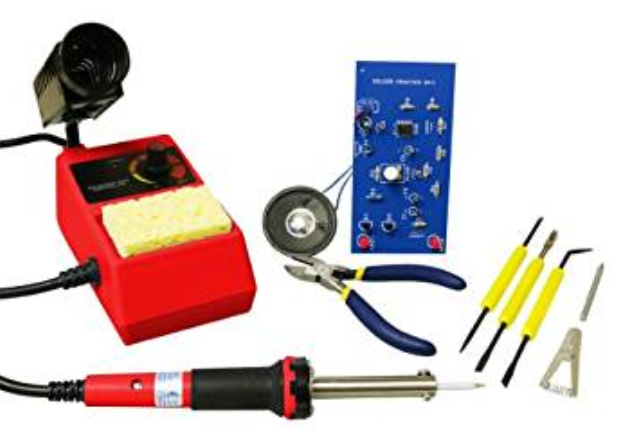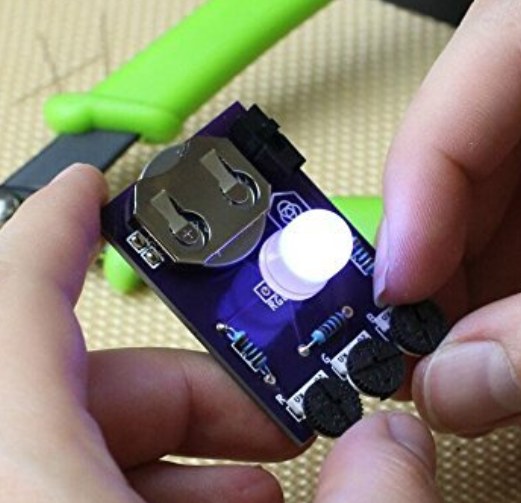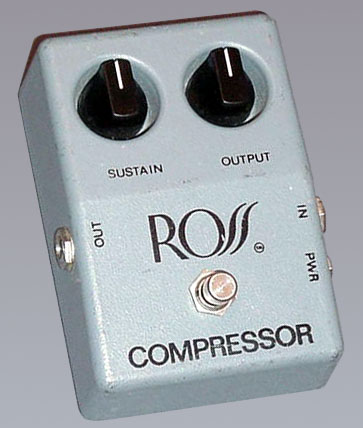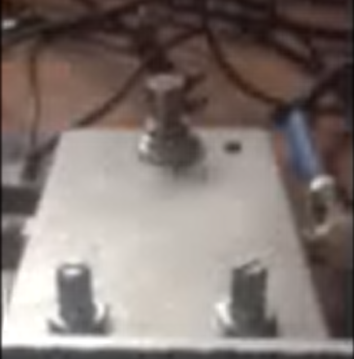The other day we had soldering cl ass at Oppedahl Patent Law Firm LLC. Everybody at the firm received a nice soldering station and soldering tools and a toolbox to keep everything in. We assembled several do-it-yourself kits that required soldering. Some of our people already knew how to solder and got through the kits pretty quickly, and others got to learn how to solder for the first time. The first kit was a “learn to solder” kit, the blue circuit board in the photograph. The circuit board for this kit has the components widely spaced, making it easy for the novice solderer to succeed. The circuit board also offers several square inches of “practice space”, including several dozen solder pads that aren’t actually hooked up to any components, but which permit the novice to gain experience with soldering and unsoldering. This kit, when powered up, yields a two-tone European type siren sound.
ass at Oppedahl Patent Law Firm LLC. Everybody at the firm received a nice soldering station and soldering tools and a toolbox to keep everything in. We assembled several do-it-yourself kits that required soldering. Some of our people already knew how to solder and got through the kits pretty quickly, and others got to learn how to solder for the first time. The first kit was a “learn to solder” kit, the blue circuit board in the photograph. The circuit board for this kit has the components widely spaced, making it easy for the novice solderer to succeed. The circuit board also offers several square inches of “practice space”, including several dozen solder pads that aren’t actually hooked up to any components, but which permit the novice to gain experience with soldering and unsoldering. This kit, when powered up, yields a two-tone European type siren sound.
We then moved on to a cute little soldering project called “Hue”. It has a tricolor light-emitting diode, and three little knobs that let you pick how much current passes through each of the three light-emitting portions of the LED. The result is that you can make many different colors in the LED by adjusting the knobs.
All of this soldering activity prompted one of our associates, Micah Gunn, to build a modern-day replica of the classic Ross Compressor Pedal from the 1970’s. Until now I did not know what a compressor pedal was. But people who play electric guitar a lot (as he does) apparently know all about compressor pedals.
As I understand it, the thing is that when you pluck a guitar string, it is loud at first, fades quickly to a lower level of loudness, and then gradually fades even more. To have a sustained tone at a fairly constant loudness level from a single pluck of the string, you could turn down the volume (amplifier gain) for the first few milliseconds and then turn the gain up and later turn the gain up even more.
As long ago as the 1950’s there were large rack-mounted electronic devices called “compressors” which would automatically turn the gain up or down as needed to provide a more nearly constant output level despite varying input levels.
What I learned just now is that a very smart audio engineer in the 1970’s named Ross designed a compressor that was physically compact (it would fit into a metal case suitable for use as a foot pedal for a guitar player) and very sturdy, and accomplished su ch a compression result with good audio quality. Nowadays a vintage Ross Compressor from the 1970’s can be gotten on eBay for many, many hundreds of dollars. If you click around on the Internet, what you will see is that the two words “Ross Compressor” are generally used only as part of a four-word phrase “the legendary Ross Compressor” or “the classic Ross Compressor”.
ch a compression result with good audio quality. Nowadays a vintage Ross Compressor from the 1970’s can be gotten on eBay for many, many hundreds of dollars. If you click around on the Internet, what you will see is that the two words “Ross Compressor” are generally used only as part of a four-word phrase “the legendary Ross Compressor” or “the classic Ross Compressor”.
I was interested to learn from Micah that there are companies that of fer kits of parts which, when assembled, are intended to replicate this Ross Compressor. Emboldened by his success in the soldering class, Micah constructed one of these kits, which you can see at right.
fer kits of parts which, when assembled, are intended to replicate this Ross Compressor. Emboldened by his success in the soldering class, Micah constructed one of these kits, which you can see at right.
Now the fun part. Micah recorded an audio-visual demonstration of the compressor. You can hear what the guitar sounds like with and without the compressor. He first plays a guitar lick without the compressor. Then he clicks the button (and the red LED lights up), and he plays the lick again. I guess one way to describe it is that there is a “sustain”. By this I mean that with the compressor in use, a particular plucked note is audible for a longer time.
What do you think about Micah’s guitar licks? Do you think the guitar sounds better with or without the compressor? Please post your comment below.

Yup. That’s a compressor. They’re great for making your guitar more prominent in a mix of other instruments during solos. And yes,they increase sustain. Nothing worse that hitting the first note of a solo,intending it to soar,and it dies out in 2 beats. Compressors are also great for taming notes that are too loud and raising the level of notes that are too quiet when recording a track in a song. The drawback from using a compressor is you can lose dynamic control when playing. Without the comp on ,strumming softly will produce a quiet, clean note or chord and strumming forcefully will produce a loud,more distorted tone. With the comp on,the guitar’s signal gets “squeezed” or “compressed” reducing the difference between loud and quiet notes. This takes away some ability of the player to manually control dynamics using picking technique. That’s what makes a foot pedal comp so handy. Just step on the switch whe your face melting guitar solo is coming up and step on it again when it’s over!
Compressors also are said to sort of emulate the natural sustain you get out of a very high volume guitar feeding back on itself a la Santana.